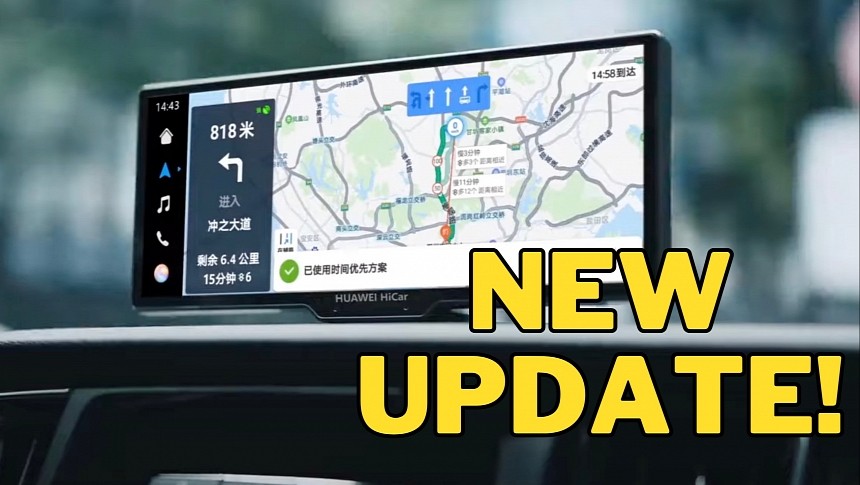Huawei's automotive ambitions revolve around software and services available in cars sold by its partners, and in addition to HarmonyOS, the company is also offering several other advanced solutions supposed to upgrade the driving experience.
One of them is HiCar, a system that's best described as an alternative to Google's Android Automotive.
Like its rival, HiCar does not require a mobile device to run, as it's pre-installed at the hardware level from the factory. In other words, it's the operating system powering the infotainment capabilities, so you won't need anything special to run it. Start the engine, and you should see HiCar loading on the screen (if the operating system is installed in the car).
Huawei has recently updated HiCar to version 13.2.0.501, and one of the highlights is an updated cruise control system. Beginning with this update, you can configure the OS to automatically enable cruise control when reaching 18.5 mph (that's about 30 kph for our European readers). Needless to say, not everybody wants the cruise control system to kick in automatically when reaching a certain speed, so HiCar also comes with additional configuration options.
For instance, when you reach the speed threshold, the system can show a cruise control icon on the display, letting you manually activate the mode. You can do this by touching the screen icon or with a voice command. At the same time, voice commands can be used to turn cruise control off, though you can always press the brake pedal to quickly disable it anyway.
In addition, the new update also includes a feature to automatically launch certain apps and show them on the home screen. This way, you can customize the dashboard screen, making sure your most important apps are always at a one-tap distance.
Besides that, HiCar is mostly unchanged, remaining one of the biggest Android Automotive alternatives currently available. Its biggest shortcoming is the limited availability, as HiCar continues to be offered exclusively to Chinese automakers. This is part of Huawei's local focus, which has been enforced primarily as a result of the sanctions the company was the subject of back in 2019.
In the meantime, Google is also working on improving Android Automotive. The company is working non-stop with carmakers across the world to adopt its operating system. The number of cars using Android Automotive is rapidly increasing, with more big names expected to join the list in 2024.
General Motors is the name that made the front page of newspapers earlier this year, as the company decided to adopt Android Automotive and give up on Android Auto and CarPlay completely. The company will install AAOS on the 2024 Blazer EV, eventually bringing the same operating system to all its zero-emission vehicles in the coming years.
Like its rival, HiCar does not require a mobile device to run, as it's pre-installed at the hardware level from the factory. In other words, it's the operating system powering the infotainment capabilities, so you won't need anything special to run it. Start the engine, and you should see HiCar loading on the screen (if the operating system is installed in the car).
Huawei has recently updated HiCar to version 13.2.0.501, and one of the highlights is an updated cruise control system. Beginning with this update, you can configure the OS to automatically enable cruise control when reaching 18.5 mph (that's about 30 kph for our European readers). Needless to say, not everybody wants the cruise control system to kick in automatically when reaching a certain speed, so HiCar also comes with additional configuration options.
For instance, when you reach the speed threshold, the system can show a cruise control icon on the display, letting you manually activate the mode. You can do this by touching the screen icon or with a voice command. At the same time, voice commands can be used to turn cruise control off, though you can always press the brake pedal to quickly disable it anyway.
In addition, the new update also includes a feature to automatically launch certain apps and show them on the home screen. This way, you can customize the dashboard screen, making sure your most important apps are always at a one-tap distance.
Besides that, HiCar is mostly unchanged, remaining one of the biggest Android Automotive alternatives currently available. Its biggest shortcoming is the limited availability, as HiCar continues to be offered exclusively to Chinese automakers. This is part of Huawei's local focus, which has been enforced primarily as a result of the sanctions the company was the subject of back in 2019.
In the meantime, Google is also working on improving Android Automotive. The company is working non-stop with carmakers across the world to adopt its operating system. The number of cars using Android Automotive is rapidly increasing, with more big names expected to join the list in 2024.
General Motors is the name that made the front page of newspapers earlier this year, as the company decided to adopt Android Automotive and give up on Android Auto and CarPlay completely. The company will install AAOS on the 2024 Blazer EV, eventually bringing the same operating system to all its zero-emission vehicles in the coming years.










